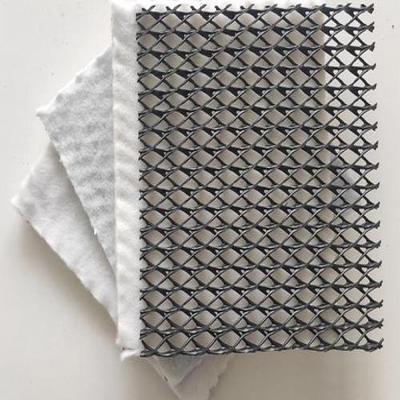In order to ensure the safety of aircraft take-off and landing, the airport runway must have good drainage performance to prevent the runway surface from being slippery and the foundation softening caused by water accumulation. Three-dimensional composite drainage network is a material commonly used in airport runways. So, what are its applications in airport runways?
1. Structure and performance of three-dimensional composite drainage network
1、The three-dimensional composite drainage net is made of high-density polyethylene ( HDPE) The three-dimensional mesh core layer formed by extrusion through special process is composed of double-sided composite geotextile. Its unique structural features include the longitudinal arrangement of rigid ribs in the middle to form a drainage channel, and the cross arrangement of ribs up and down to form a support to prevent the geotextile from being embedded in the drainage channel. Therefore, it has super drainage performance, tensile strength and shear strength.
2、The three-dimensional composite drainage network has large interlayer gaps, and the drainage volume per minute can reach 20% ~200Cubic centimeters, enabling the rapid and efficient removal of accumulated liquid. It is also weather resistant and very good toughness, allowing it to maintain consistent performance even in harsh climatic conditions.
2. Requirements for drainage system of airport runway
1、Airport runways have extremely high requirements for drainage systems, because accumulated water will not only affect the safety of aircraft takeoff and landing, but may also cause softening and damage to the runway foundation. An efficient drainage system needs to be able to quickly remove standing water from the runway surface in a short period of time and keep the runway foundation dry and stable.
2、In order to meet these requirements, the drainage system of airport runway generally includes main drainage channel, branch drainage channel, rainwater collection tank and drainage materials. The choice of drainage materials is very important, which can affect the efficiency and durability of the drainage system.
3. Application advantages of three-dimensional composite drainage network in airport runways
1、Excellent drainage performance: The three-dimensional composite drainage net can quickly and effectively drain the accumulated water on the runway surface, prevent the runway from being slippery, and ensure the safety of aircraft take-off and landing.
2、Enhance foundation stability: The three-dimensional composite drainage network can isolate the fine materials of the base from entering the foundation, enhance the support of the foundation, and prevent the softening and damage of the foundation. Its rigid rib structure can also play a stiffening role and improve the overall stability of the runway.
3、Durability and environmental protection: The three-dimensional composite drainage network is corrosion-resistant and wear-resistant, and is not easy to be damaged under various harsh weather conditions. In addition, it can be recycled and reused, which meets environmental protection requirements.
4、Convenient construction: The three-dimensional composite drainage net is supplied in coil form, which is easy to lay and transport. During construction, connections can be made by means of welding or stitching, ensuring the continuity and integrity of the drainage system.
5、Significant economic benefits: Although the initial investment of three-dimensional composite drainage network may be high, its excellent performance and durability greatly reduce maintenance costs. In the long run, the use of three-dimensional composite drainage network can improve the service life and operation efficiency of airport runways, and bring remarkable economic benefits.
It can be seen from the above that the three-dimensional composite drainage network has excellent drainage performance, stability and durability, and shows great application potential in airport runway construction. With the continuous development of air transport industry, the requirements for the safety and efficiency of airport runways will be higher and higher.
Post time: Mar-31-2025





